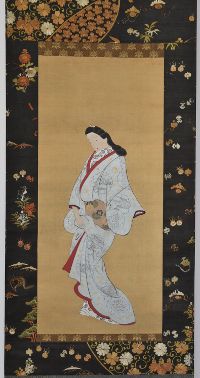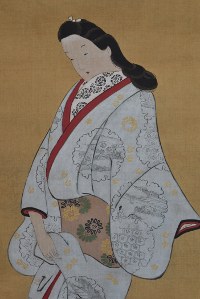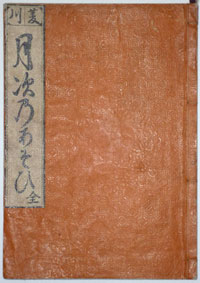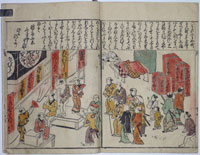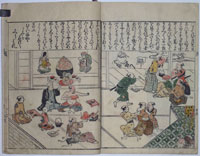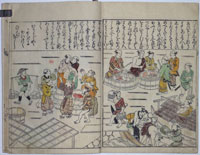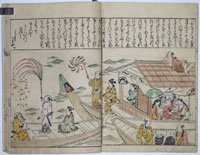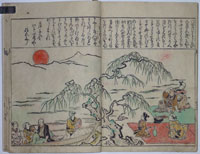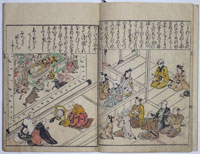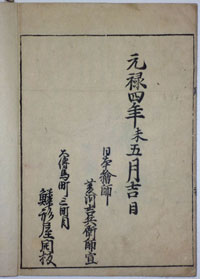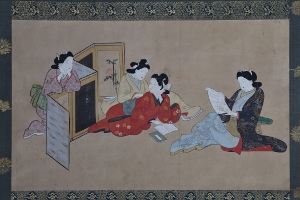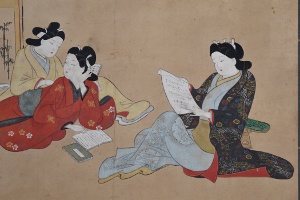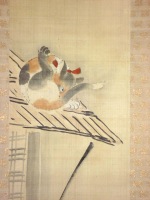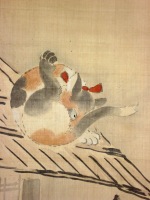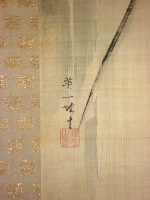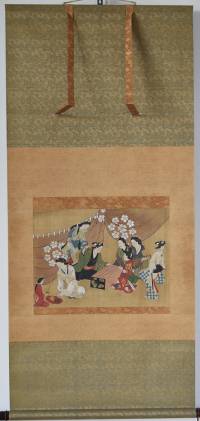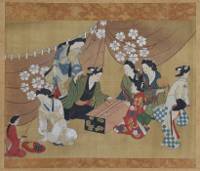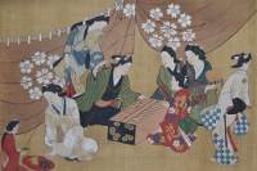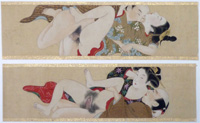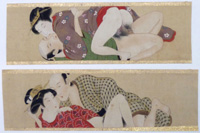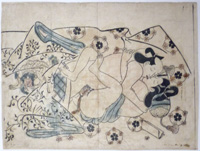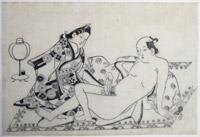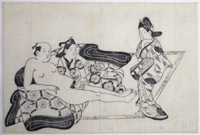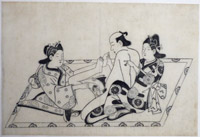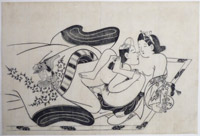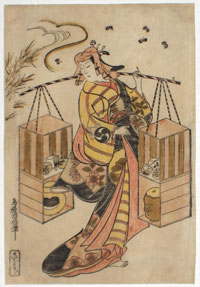Hishikawa MORONOBU (C. 1618-1694)
Click here to view image full size.
An important figure and pioneer of the ukiyo-e school. He was born into a family of embroiderers and textile dyers at Hota in Awa Province, but departed for Edo, c. 1658, to study painting. A prolific artist, he illustrated a large number of books, as well as being the first to design single-sheet prints. Turned to painting c. 1670. Shows a promenading beauty, knees slightly bent and the long face typical of Moronobu. The delicately painted kimono has serrated roundels with images of Heian court life or abstract patterns interspersed with small gold flower heads.
An original painting on silk, image size 23.5 x 10.75 in; 59.75 x 27 cms with an old elaborately embroidered mount. Unsigned, as is often the case with 17th century paintings. In very good condition.
Status: Sold
Hishikawa MORONOBU (c. 1618-1694)

Click here to view image full size.
The father of Ukiyo-e and the first to design single-sheet prints. Illustrated numerous books and produced a considerable number of paintings. A good proportion of his output was in the form of shunga. The print here is, arguably, from his finest shunga album. A set of 12 prints, although it is known in two versions with two alternative designs making a total of 14 sheets. For one complete set see Shunga The Art Of Love In Japan, Tom and Mary Evans, Paddington Press, 1975, Illus. 5.10-5,21. Rare.
Very good impression. Original hand-colouring. Minor marks and signs of mounting au verso, but otherwise very good condition.
Status: Sold
Hishikawa MORONOBU (c 1618–1694)
Click here to view image full size.
A superb and important book by an unrivalled illustrator in depicting street life and views of the Yoshiwara and the theatre. One volume complete, Tsukinami no asobi, “Months in the Eastern [ Edo] Capital.” One page preface and 19 double page illustrations plus one page colophon. Shows the inhabitants of Edo engaged in various activities from pleasure to devotion as well as street markets and daimyo processions. Published by Urokogata-ya of Odenba-cho, Edo, Genroku 4, 4th month, 1691. Beautiful contemporary hand colouring. Ex collection Walter von Scheven, 1878 – 1950, and purchased by him from Karl W. Hiersemann, Leipzig, in 1924. Extremely rare. Listed by Mrs Brown in Block Printing and Book Illustration in Japan, p. 48.
Original salmon pink covers with embossed pattern and original title slip. Minor soil and marks but otherwise extremely good condition for a book of this period.
Status: Sold
Hishikawa MOROSHIGE (FL. 1684-1704)
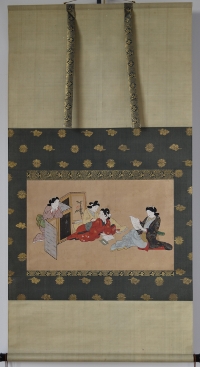
Click here to view image full size.
An original painting showing a high-ranking samurai household at leisure. Moroshige was the senior pupil of Hishikawa Moronobu, and, it is said, was the father of Furuyama Moromasa. Sumi and full colour with gold additions on paper. 11.5 x 19 in; 29 x 48.25 cms. This is most likely from a handscroll as the height is correct, and the slight vertical striations indicate it has been rolled at some time. Painted c. 1700. Some slight loss of pigments, especially the verdigris and minor marks, but all commensurate with the age of the painting. The details on the costumes of the two main figures are exquisite.
Status: Available
Hishikawa MOROSHIGE (Fl. 1684-1704)

Click here to view image full size.
An original painting, sumi and full colour on paper, 24 x 12 in; 61 x 30.5 cms. Shows a beautiful youth (a wakashu) dressed as a girl with his attendant servant. These youths (identified as male by wearing a sword) were arbiters of trend-setting kimono design. They are sometimes referred to as the “third gender,” and were sexually ambiguous being objects of desire to both adult men and women. Moroshige was the senior pupil of Hishikawa Moronobu, and, it is said, was the father of Furuyama Moromasa. Some toning of paper and slight loss of pigment, but all commensurate with a painting of this age. Otherwise good condition. Painted around 1700.
Signed Hishikawa Moroshige zu with seal Moroshige. A fine and interesting painting.
Status: Available
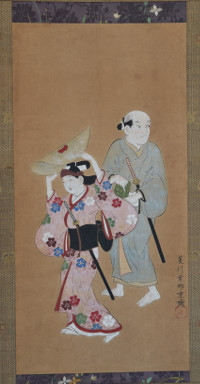
Click here to view image full size.
Hanabusa ITCHO ( 1670-1724 )
Click here to view image full size.
An original painting showing a cat cleaning itself on a precarious tea-house roof. A charming study and typical of his work which often depicted the commonplace and comical sides to life. Itcho first studied the Kano tradition, perhaps under Kano Yasunobu ( 1618-1685 ). He was also known in poetry circles. However, like a lot of other artists of the time, he ran foul of the authorities and was exiled for 12 years in Miyakejima. On his return in 1709 he adopted the name Hanabusa Itcho and focused on ukiyo-e painting following in the footsteps of Moronobu but with more of a common touch. Ink and colour on silk. Image size 40.5 x 9.25 in; 113 x 23.5 cms.
Signed Hanabusa Itcho with seal Nobuka no in. Box inscription Hanabusa Itcho Okujo no neko. Painted c 1710-20. In very good condition. Copies of Itcho paintings and drawings abound, partly because of his popularity and importance, but also because his staccato-like style and often simple subjects lend themselves to plagiarism. This lovely and unusual composition shows Itcho at his best. See also: Hanabusa Itcho ten ( exhibition catalogue ), Itabashi Museum of Art, 1984 ( see pl. 20 for the identical seal and very similar signature ); M. Murase, Japanese Art: Selections from the Mary and Jackson Burke Collection, Metropolitan Museum of Art, 1975, cat. No. 89; and for a description of his life: T. Koyasahi, Life of Hanabusa Itcho, Kokka, vol. 920, 1968, 00. 5-10.
Status: Available
Hishikawa MOROSHIGE (Fl. 1684-1704)
Click here to view image full size.
An original painting showing a go game being watched by beautifully attired ladies. Moroshige was the senior pupil of Hishikawa Moronobu, and, it is said, was the father of Furuyama Moromasa. Sumi and full colour with extensive gold on silk; 10.75 x 15 in; 27.5 x 38 cms. Newly remounted with futomaki and box. Provenance: Ex William Sturgis Bigelow collection. He was one of the first Americans to live in Japan and much of his extensive collection went to the Museum of Fine Arts, Boston. His original seal has been affixed to the side of the box.
Painted c. 1700. In very good condition. Rare: A fine painting and nice subject.
Status: Sold
Sugimura JIHEI (Acitive c. 1681-1703)

Click here to view image full size.
A shunga print showing a samurai (his swords lying outside the screen) having sexual intercourse with a courtesan from a set of twelve such prints published mid 1680s. Jihei was the most impressive of Moronobu’s followers and seems to have specialised in shunga, often surpassing Moronobu. (Indeed, Jihei’s work was attributed to Moronobu for a long time.) Hand coloured, although probably not from the period but still with considerable age. Extremely rare.
Fine impression. Very good condition.
Status: Sold
Tsukioka SETTEI (1710-1786)
Four original paintings on silk. An artist who developed a style somewhere between Moronobu and Sukenobu. Well known for his elegant erotica painted with great refinement. Sizes vary from 3.25 in; 5.5 cms. x 12.75 in; 32.5 cms. to 3.25 in; 5.5 cms. x 11.5 in; 29 cms. Full colour and obviously taken from a hand scroll of 12 such paintings. Mounted onto gold-flecked paper. Unsigned.
Status: Sold
Sugimura JIHEI (Fl. c. 1680-1698)
Click here to view image full size.
The most prolific of Moronobu’s pupils and was originally confused with him, but now properly identified as a separate artist. Produced some of the finest erotic designs. A couple in flagrante beneath a sumptuous duvet. Published c. mid 1680’s.
A large oban ( 11in; 27cms x 14.5in; 36.75cms ).
Good impression. Some restorations but generally good condition. Partially hand-coloured. Unsigned ( as usual ).
Status: Sold
Hishikawa MOROSHIGE (active c. 1684-1695)
Click here to view image full size.
A shunga print by the best of Moronobu’s direct pupils, who produced some of the finest designs in this genre. Shows a couple prior to coitus. Published c. mid 1680s.
Very good impression. Very slight soil and weakening along laid lines, but otherwise very good condition. Unsigned.
Status: Sold
Hishikawa MOROSHIGE (active c. 1684-1695)
Click here to view image full size.
A shunga print by the best of Moronobu’s direct pupils, who produced some of the finest designs in this genre. Shows a couple prior to coitus being approached by an attendant. Published c. mid 1680s.
Very good impression. Very slight soil and weakening along laid lines, but otherwise very good condition. Unsigned.
Status: Sold
Hishikawa MOROSHIGE (active c. 1684-1695)
Click here to view image full size.
A shunga print by the best of Moronobu’s direct pupils, who produced some of the finest designs in this genre. Shows a couple in flagrante aided by an attendant. Published c. mid 1680s.
Very good impression. Very slight soil and weakening along laid lines, but otherwise very good condition. Unsigned.
Status: Sold
Hishikawa MOROSHIGE (active c. 1684-1695)
Click here to view image full size.
A shunga print by the best of Moronobu’s direct pupils, who produced some of the finest designs in this genre. Shows a couple in flagrante, the huge duvet slipping off their bodies. Published c. mid 1680s.
Very good impression. Very slight soil and weakening along laid lines, but otherwise very good condition. Unsigned.
Status: Sold
Torii KIYOMASU I (Active c1700-1722)
Click here to view image full size.
The actor Nakamura Takesaburo playing a female itinerant tea vendor. A pair of panniers is slung across his shoulders holding the paraphernalia for tea making including, in the lower sections, a brazier and water jug. Published c1716-20 by Sagamiya. Published in Yamaguchi and Asano ( 1982 ), Moronobu – Harunobu, vol.6 of the Complete Dictionary of Ukiyo-e, Tokyo, Shogakukan, pl.86, p.46. Probably the only known impression extant.
Very good impression with fine contemporary hand-colouring. Expertly restored corners and areas at left and bottom edges. One repaired wormhole beside the hand holding the bamboo rod. Signed Torii Kiyomasu hitsu.
Status: Sold
Artists
( A to Z )
Kyogado ASHIKUNI ( Fl. c. 1807 – 1818 )
Gigado ASHIYUKI ( Fl. c. 1814 – 1833 )
Ki BAITEI ( 1734 – 1810 )
Takizawa BAKIN ( 1767 – 1848 )
Ono BAKUFU ( 1888 – 1976 )
Georges BIGOT ( 1860 – 1927 )
Kawamura BUMPO ( 1779 – 1821 )
Ippitsusai BUNCHO ( Fl. c. 1765 – 1792 )
Toyohara CHIKANOBU ( 1838 – 1912 )
Kishi CHIKUDO ( 1826 – 1897 )
Tsubaki CHINZAN ( 1801 – 1854 )
Eishosai CHOKI ( Fl. c. 1756 – 1808 ). See also SHIKO
Rekisentei EIRI ( Fl. c. 1790 – 1800 )
Keisai EISEN ( 1790 – 1848 )
Hosoda EISHI ( 1756 – 1829 )
Hosoda EISHO ( Fl. c. 1780 – 1800 )
Ichirakutei EISUI ( Fl. c. 1790 – 1823 )
Kikugawa EIZAN ( 1787 – 1867 )
Hirano HAKUHO ( 1879 – 1957 )
Elizabeth KEITH ( 1887 – 1956 )
Imao KEINEN ( 1845 – 1924 )
Yashima GAKUTEI ( 1786 – 1868 )
Ogata GEKKO ( 1859 – 1920 )
Adachi GINKO ( Fl. c. 1847 – 1897 )
Matsumura GOSHUN ( 1752 – 1811 )
GYOSAI. See Kawanabe KYOSAI
Hirano HAKUHO ( 1879 – 1957 )
Suzuki HARUNOBU ( 1724 – 1770 )
Kawase HASUI ( 1883 – 1957 )
Kitagawa HIDEMARO ( Fl. c. early 19th century )
Kinoshita HIRONOBU ( Fl. c. 1851 – 1870 )
Gosotei HIROSADA ( Fl. c. 1847 – 1863 )
Ichiryusai HIROSHIGE ( 1797 – 1858 )
Ichiryusai HIROSHIGE II ( 1826 – 1869 )
Ando HIROSHIGE III ( 1843 – 1894 )
Nakamura HOCHU ( Fl. c. late 18th to early 19th century )
Sakai HOITSU ( 1761 – 1828 )
Totoya HOKKEI ( 1780 – 1850 )
Teisai HOKUBA ( 1771 – 1844 )
Shunkosai HOKUEI (Active 1824-1837)
Katsushika HOKUGA ( Fl. c. 1830 )
Shotei HOKUJU ( Fl. c. 1789 – 1818 )
Katsushika HOKUSAI ( 1760 – 1849 ). Also used numerous other names such as: SORI, SHUNRO, SHINSAI
Shokosai HOKUSHU ( Fl. c. 1808 – 1832 )
KEISAI. See Kitao MASAYOSHI
Suzuki KIITSU ( 1796 – 1858 )
Kitagawa KIKUMARO ( Fl. c. ? – 1830 ). See TSUKIMARO
Kobayashi KIYOCHIKA ( 1847 – 1915 )
Torii KIYOHIRO ( Fl. c. 1737 – 1771 )
Torii KIYOMASA ( Fl. c. 1700 – 1722 )
KIYOMINE. See Torii KIYOMITSU II
Torii KIYOMITSU ( 1735 – 1785 )
Torii KIYOMITSU II ( 1787 – 1868 ). See KIYOMINE
Torii KIYONAGA ( 1752 – 1815 )
Torii KIYONOBU ( 1664 – 1729 )
Torii KIYONOBU II ( 1706 – 1763 )
Torii KIYOTSUNE ( Fl. c. 1757 – 1779 )
Isoda KORYUSAI ( Fl. c. 1767 – 1788 )
Ohara KOSON ( 1877 – 1945 ). See SHOSON
Torii KOTONDO ( 1900 – 1976 )
Toyohara KUNICHIKA ( 1835 – 1900 )
Utagawa KUNIHIRO ( Fl. c. 1815 – 1843 )
Ichiunsai KUNIHISA ( 1832 – 1891 )
Utagawa KUNINAO ( 1793 – 1854 )
Utagawa KUNISADA ( 1786 – 1865 )
Utagawa KUNISADA II ( 1823 – 1880 )
Utagawa KUNISATO ( ? – 1858 )
Utagawa KUNITERU ( 1808 – 1876 )
KUNITERU. See Utagawa SADASHIGE
Utagawa KUNITERU II ( 1829 – 1874 )
Utagawa KUNIYASU ( 1794 – 1832 )
Ichiyusai KUNIYOSHI ( 1797 – 1861 )
Santo KYODEN. See Kitao MASANOBU
Kawanabe KYOSAI ( 1831 – 1889 ). See GYOSAI
Okumura MASANOBU ( 1686 – 1764 )
KitaoMASANOBU ( 1761 – 1816 ). See Santo KYODEN
Kitao MASAYOSHI ( 1764 – 1824 ). See KEISAI
Oishi MATORA ( 1794 – 1833 )
Hishikawa MORONOBU ( Fl. c. 1618 – 1694 )
Nishimura NANTEI ( 1775 – 1834 )
Utagawa NOBUKATSU ( Fl. c. 1830 – 1844 )
Watanabe NOBUKAZU ( Fl. c. late 19th century )
Hishikawa RYUKOKU ( Fl. c. 1808 – 1816 )
Jokei RYUKOSAI ( Fl. 1772 – 1816 )
Gokitei SADAFUSA ( Fl. c. 1825 – 1850 )
Hasegawa SADAHARU ( Fl. c. 1830 – 1844 )
Gokotei SADAKAGE ( Fl. c. 1818 – 1844 )
Utagawa SADAHIDE ( 1807 – 1873 )
Hasegawa SADANOBU ( 1809 – 1879 )
Utagawa SADASHIGE ( Fl. c. mid 19th century ). See KUNITERU
Gofutei SADATORA ( Fl. c. 1825 )
Yamaguchi SHIGEHARU ( 1803 – 1853 )
Kitao SHIGEMASA ( 1739 – 1820 )
Nishimura SHIGENAGA ( 1697 ? – 1756 )
Nishimura SHIGENOBU ( Fl. c. 1724 – 1735 )
SHIKO. See Eishosai CHOKI
Ryuryukyo SHINSAI ( 1764 – 1820 )
Ito SHINSUI ( 1898 – 1972 )
Kojima SHOGETSU ( Fl. c. 1880 – 1890 )
SHOSON. See Ohara KOSON
Takahashi SHOTEI ( 1871 – 1945 )
Yamamoto SHOUN ( 1870 – 1965 )
Yamakawa SHUHO ( 1898 – 1944 )
Katsukawa SHUNCHO ( Fl. c. 1780 – 1795 )
Takehara SHUNCHOSAI ( Fl. c. 1772 – 1801 )
Katsukawa SHUN’EI ( 1762 – 1819 )
Katsukawa SHUNKO ( 1743 – 1812 )
Hishikawa SHUNKYO ( Fl. c. early 19th century )
Kubo SHUNMAN ( 1757 – 1820 )
Katsukawa SHUNSEN ( Fl. c. 1762 – 1830 )
Natori SHUNSEN ( 1886 – 1960 )
Gatoken SHUNSHI ( Fl. c. 1820 – 1828 )
Katsukawa SHUNSHO ( 1726 – 1792 )
Katsukawa SHUNTEI ( 1770 – 1820 )
Katsukawa SHUNZAN ( Fl. c. 1782 – 1798 )
Yamaguchi SOKEN ( 1759 – 1834 )
Ikeno TAIGA ( 1723 – 1776 )
Katsukawa TERUSHIGE ( Fl. c. 1715 – 1725 )
Mori TETSUZAN (1775-1841)
Migita TOSHIHIDE ( 1863 – 1925 )
Mizuno TOSHIKATA ( 1866 – 1908 )
Okumura TOSHINOBU ( Fl. c. 1717 – 1750 )
Utagawa TOYOHARU ( 1735 – 1814 )
Utagawa TOYOHIRO ( 1773 – 1828 )
Utagawa TOYOKUNI ( 1769 – 1825 )
Utagawa TOYOKUNI II ( 1777 – 1835 ). See TOYOSHIGE
Yamamura TOYONARI ( 1885 – 1942 )
Ishikawa TOYONOBU ( 1711 – 1785 )
TOYOSHIGE. See Utagawa TOYOKUNI II
TSUKIMARO. See Kitagawa KIKUMARO
Kitano TSUNETOMI ( 1880 – 1947 )
Toyokawa UMEKUNI ( Fl. c. 1816 – 1826 )
Kitagawa UTAMARO ( 1753 – 1806 )
Kitagawa UTAMARO II ( ? – 1831 )
Inoue YASUJI ( 1864 – 1889 )
Hiroshi YOSHIDA ( 1876 – 1950 )
Ipposai YOSHIFUJI ( 1828 – 1887 )
Utagawa YOSHIIKU ( 1833 – 1904 )
Utagawa YOSHIKATA ( Fl. c. 1841 – 1864 )
Utagawa YOSHIKAZU ( Fl. c. 1850 – 1870 )
Toyokawa YOSHIKUNI ( Fl. c. 1803 – 1840 )
Utagawa YOSHIMUNE ( 1817 – 1880 )
Ichiyosai YOSHITAKI ( 1841 – 1899 )
Utagawa YOSHITORA ( Fl. c. 1850 – 1880 )
Taiso YOSHITOSHI ( 1839 – 1892 )
Utagawa YOSHITSURU ( Fl. c. 1840 – 1850 )
Ichieisai YOSHITSUYA ( 1822 – 1866 )
Mori YOSHIYUKI ( 1835 – 1879 )
Shibata ZESHIN ( 1807 – 1891 )

